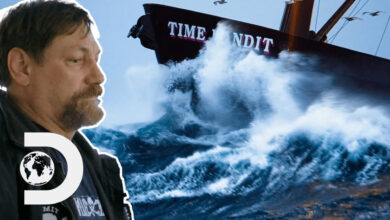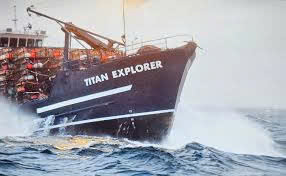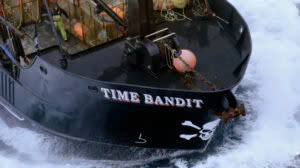Behind the Thrilling Scenes: How Deadliest Catch Maintains Its Stellar Image Amidst Dangerous Conditions and Unrevealed Behind-the-Scenes Secrets?
Behind the Thrilling Scenes: How Deadliest Catch Maintains Its Stellar Image Amidst Dangerous Conditions and Unrevealed Behind-the-Scenes Secrets?

Discovery’s “Deadliest Catch” has been documenting the journey of fishing ships to one of the most remote places in the world, the Bering Sea, to catch king crab and snow crab. In an environment where severe weather and high swells are frequent, it is one of the most difficult and dangerous places imaginable to film. It is also one of the most demanding jobs in all of television, requiring a set of skills not normally asked of a Hollywood camera department.
Here’s eight ways the camera team survives the hardest job in television, and still gets astounding images.
In an environment where the cameraperson is on a large boat that is often found heaving up and down over 30 foot swells, there are significant physical attributes needed before the creative part of the job even comes into play.
“The recruiting process is unique because they need to be able to endure that environment,” said Executive Producer Arom Starr-Paul, who started off on “Deadliest Catch” as a camera operator. “You need to have an iron stomach. [Tolerating] motion sickness is the first requirement of the job. You need to be able to go out on those boats and sustain a level of health and operation so you can actually do the job, and it’s hard to find those guys.”
For most people trying to keep their bearings on rough sea, the trick is to get to the center of the boat and keep your eyes focused on the horizon, but that’s not an option while shooting. “You have one eye in a viewfinder trying to level the frame, and then your other eye is open looking for your next shot as the boat is moving under you,” said Starr-Paul. “You have two horizons you’re dealing with, with your eye in the viewfinder and your other one that’s open still looking for the next shot. It really is disorienting in every way
2. Strength and Sleep Deprivation
All of this is complicated by sleep deprivation. The ships are often out at sea seven to 14 days before returning the docks in Dutch Harbor. During this period, the on-board camera crew is often working 19 to 20 hours a day.
“That’s something that was a little bit surprising as you are operating on normally about four hours [of sleep] a day in a 24-hour period,” said series director of photography David Reichert, who had been on “Deadliest Catch” for seven seasons. “That starts to add up, and there can even be longer runs in there. Your senses dull a little bit, to say the least, when that happens.”
Reichert’s camera team needs to be in top physical shape. A popular saying on the show is “the Bering Sea has 100 percent injury rate” – meaning you will get beat up and physically worn down shooting “Deadliest Catch.” And while Reichert conducts a week-long intensive “film school” prior to production to teach techniques and hone skills that will help each member of the team better tackle these challenges, it also takes raw skill and strength.
3. Safety
It was only two seasons ago that one of the ships that the series looked at and seriously considered shooting on – a fishing vessel called Destination – experienced a tragic accident at sea in which the entire crew of six people lost their lives. The rough seas combined with the dangerous work of commercial fishing means safety is a primary concern.
It begins with training from the Coast Guard. While over the series’ 15 seasons it has documented the frightening instances of members of the fishing crew going overboard, the show has been fortunate that no member of the film crew has been thrown from the vessel. Still, extensive training for man-overboard drills is required at the start of the season.
“The first step is getting everybody trained up on protocol on what to do in the worst-case scenario,” said Starr-Paul. “Then once they’re on the vessel, they go through the 2.0 version of that with all the captains on what the procedures are, where the rally points are, and what to do in case of an emergency. That’s the baseline training they have for their own personal safety.”
4. Spatial Orientation: Knowing Where To Be
Reichert said his biggest learning curve, not only in terms of safety, but also in being an effective cameraperson, was figuring out where to stand when filming. “First of all, it’s about not getting smashed when you are on the deck,” he said. “The [crab] pots, which are 1,000 lbs. each, and are literally swinging around this deck because they move them with these cranes. So, you have to stay out of the way of those. I was maybe a little overexcited to do some good work and got myself in some bad places right away when I was first starting out on the show. I was bailed out of those by the crew of the boat, who watched me and basically pulled me out of situations.”
Eventually, Reichert says the key as a cameraperson is to watch the fishing crew and not only anticipate their actions, but to know where to move to based on what they are doing. “There is a lot to know because [when] different things happen, like a pot is coming over the rail, there’s certain places you can be and certain places you can’t,” said Reichert. “When they move the pot with the crane, it’s a whole other set of places. When they’re throwing the buoys over the rail, if you are standing where the lines are going out, it catches your foot, you go over the rail with it.”
It’s too much to figure out at first, which is why the newer camera team members rely on the fisherman to help them figure out where they can go, but once gaining the requisite spatial orientation, according to Reichert, it becomes instinctive, as does the best place to capture different types of action.
5. Utilizing Advanced Camera Technology
Much of “Deadliest Catch” is filmed at night. Reichert and Starr-Paul are proud of how the visual quality of the show has improved significantly over the seasons, in part because the show has been quick to adopt the latest technology as cameras get lighter in weight and able to handle lower-light levels.
For example, not that many years ago in order to see the captain up in the wheelhouse, a key part of each episode’s narrative, the “Deadliest Catch” team had to rely on infrared cameras that produced an unpleasing, green, grainy image, before Sony started make the small, light sensitive A7S, followed by the Canon C300 Mark II allowing them to shoot at a 6400 ISO. One of the biggest tech breakthroughs happened this last season with the switch to a new generation of Panasonic cameras that have dual ISO technology in their VariCam LT, which is frequently partnered with the EVA1 on deck.

The biggest difference has not only been a cleaner, less grainy image, but the most colorful nighttime cinematography the show has ever had. The EVA1’s size is what made this upgrade possible. “We always strive to have the best image quality,” said Reichert. “But there is that balance of what a camera operator can realistically have on their shoulder for hours on end in this environment. So, we’re always looking for the newest and the best tool that is light, but can still achieve a really cinematic and high-quality image. This season we changed our camera setup that was on the boats for the two operators.
6. Saltwater, Ziploc Bags, and a “Disposable” Camera
The smaller Panasonics have become the workhorse camera on the dangerous deck stage because of their size and low light image quality, but there’s another factor as well. “The third thing that we really care about is just how durable the camera is,” said Starr-Paul. The cameras on “Deadliest Catch” take a ton of abuse. Camera operators fall down constantly, cameras get banged, water is constantly splashing. “It’s saltwater nonstop, and that just is the death of all electronics.”
Over the years the series has experimented and spent thousands of dollars experimenting with custom carbon fiber housing to trying all the high-priced camera bags on the market — most of which proved as burdensome. “What we have come back to is a Ziploc XL bag that is then modified for the cameras,” said Reichert. “It really is the lightest and turns out to be the way that the guys can operate the cameras the easiest.”
That all having been said, the affordable, camcorder-style EVA1’s are also the right price point to be the workhorse deck camera, as each cameraperson will go through at least a handful each season. “It has to be a price point that is expendable,” said Reichert. “Some of them have actually just gone overboard. One operator was falling overboard, and his only way, at least at the time he thought, was to throw his camera overboard to hopefully push him back the other way. So, that happened, but at least he didn’t go overboard.”
7. Dynamic Coverage
Each season the “Deadliest Catch” team tries to up their game in terms of coverage. While on board the actual fishing ships using a big expensive RED camera and shooting at 6K doesn’t make financial or practical sense, using this camera combined with top-of-the-line gimbals on chase boats and helicopters has gives the editing team an important outside-the-boat perspective and needed wide shots.
Onboard, camera operators are also armed with A7S cameras to get special slow-motion shots and shallow focus portrait shots. When things are calm, they’ll even attempt a zipline shot as the camera glides across the bow. “There is time to do that specialty photography, and take their time and really get beautiful images to augment the story,” said Reichert. “The editors are now need all those images to really get the look that ‘Deadliest Catch’ is these days.”
One of the biggest tools is the the miniature handheld gimbal cameras made by Osma, which the on-board camera team attaches and moves to fixed points all along the ship. “These cameras that are mounted off the sides of the boat, because just to feel that frontier of the metal and the sea is really an important part of what we do,” Reichert.
The fixed cameras are also part of what allows the camera crew to be safe and not miss key action. “When it comes to safety and participating in if there were a man overboard, something like that, we have fixed cams on the boats for a reason,” said Starr-Paul. “The fixed cams really capture a lot of the actual events because when your life is really in peril, the priority is putting your hand down and grabbing a bar to keep from going overboard or to help someone whose life is being threatened. That’s always what’s prioritized above content, but we have fixed cams in place to capture the narrative, to capture the events as they unfold.”
8. Sound Recording and Media Manager
In addition to balancing a myriad of cameras, impossible shooting conditions, and lack of sleep, the camera operators on-board the fishing vessels are also in charge of sound. “As a DP, I hate to say it, but sound can trump image from time to time,” said Reichert. The standard mic set-up for Season 15 was three lav mics for three of the deck crew, a fourth lav for the captain, and then fixed shotgun microphones on the deck, in the wheelhouse, and on each camera.

“There’s a lot of work into going into that, and also they have to monitor this audio, make sure we’re not over-modulating,” said Reichert. “So they’re responsible that these lavs are in the right place on the guys, that they’re not just hearing rain gear rustle, and they’re on the right channel. All of that has to go well. We’ve backed it up, we are isolated on every track, so we can go dig it all out, but when you’re following somebody, you definitely want to hear them, not the whole show, so you have to be on the right channel.”
And at the end of the extremely long, grueling day, not only are the “Deadliest Catch” camera operators responsible for caring for and charging all their gear, they are also also charged with managing and backing up their footage.
“The typical fishing trip where the boats are out at sea and they have no access to anybody, is seven to 14 days, before the boats come in and offload their crab,” said Reichert. “That is the only chance for us to get the media. So, these boat producers/shooters are managing their media. We have them set up with a station, and they’re putting it on a couple of drives, and then when they come in, we’ll trade out their drives. So, they have their master, which is the big backup, and then we’ll grab their drives. That media is on that boat until they come in, and there’s just no way around it.”






